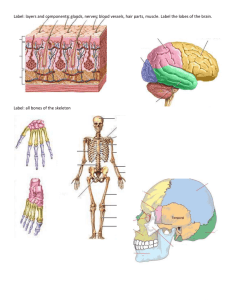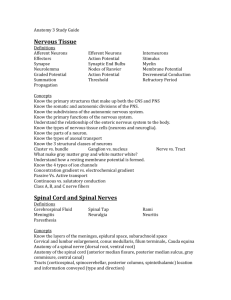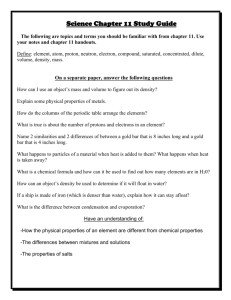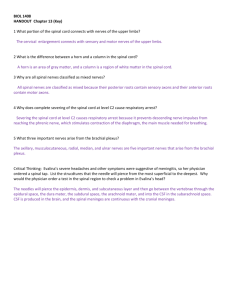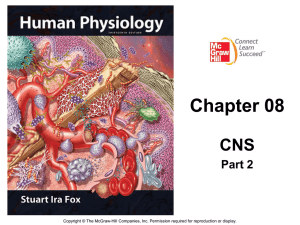Exam 3
advertisement
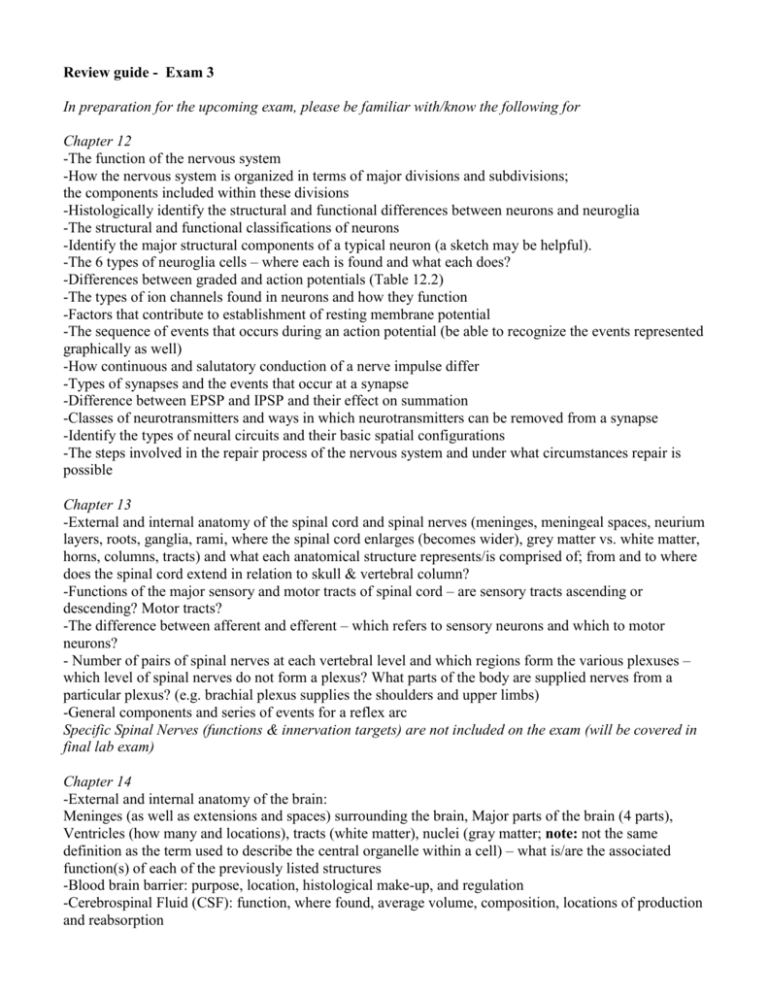
Review guide - Exam 3 In preparation for the upcoming exam, please be familiar with/know the following for Chapter 12 -The function of the nervous system -How the nervous system is organized in terms of major divisions and subdivisions; the components included within these divisions -Histologically identify the structural and functional differences between neurons and neuroglia -The structural and functional classifications of neurons -Identify the major structural components of a typical neuron (a sketch may be helpful). -The 6 types of neuroglia cells – where each is found and what each does? -Differences between graded and action potentials (Table 12.2) -The types of ion channels found in neurons and how they function -Factors that contribute to establishment of resting membrane potential -The sequence of events that occurs during an action potential (be able to recognize the events represented graphically as well) -How continuous and salutatory conduction of a nerve impulse differ -Types of synapses and the events that occur at a synapse -Difference between EPSP and IPSP and their effect on summation -Classes of neurotransmitters and ways in which neurotransmitters can be removed from a synapse -Identify the types of neural circuits and their basic spatial configurations -The steps involved in the repair process of the nervous system and under what circumstances repair is possible Chapter 13 -External and internal anatomy of the spinal cord and spinal nerves (meninges, meningeal spaces, neurium layers, roots, ganglia, rami, where the spinal cord enlarges (becomes wider), grey matter vs. white matter, horns, columns, tracts) and what each anatomical structure represents/is comprised of; from and to where does the spinal cord extend in relation to skull & vertebral column? -Functions of the major sensory and motor tracts of spinal cord – are sensory tracts ascending or descending? Motor tracts? -The difference between afferent and efferent – which refers to sensory neurons and which to motor neurons? - Number of pairs of spinal nerves at each vertebral level and which regions form the various plexuses – which level of spinal nerves do not form a plexus? What parts of the body are supplied nerves from a particular plexus? (e.g. brachial plexus supplies the shoulders and upper limbs) -General components and series of events for a reflex arc Specific Spinal Nerves (functions & innervation targets) are not included on the exam (will be covered in final lab exam) Chapter 14 -External and internal anatomy of the brain: Meninges (as well as extensions and spaces) surrounding the brain, Major parts of the brain (4 parts), Ventricles (how many and locations), tracts (white matter), nuclei (gray matter; note: not the same definition as the term used to describe the central organelle within a cell) – what is/are the associated function(s) of each of the previously listed structures -Blood brain barrier: purpose, location, histological make-up, and regulation -Cerebrospinal Fluid (CSF): function, where found, average volume, composition, locations of production and reabsorption -Location and function of subdivisions of brain: brain stem = medulla oblongata, pons, midbrain (mesencephalon); diencephalon = thalamus, hypothalamus, epithalamus; cerebrum = 2 hemispheres and 5 lobes -Difference among tract types regarding white matter in brain (association, commissural, & projection) -The difference between a gyrus, sulcus, & fissure -General functions and location of the Limbic system -Functional organization of the cerebral cortex - generally speaking, what are the responsibilities of each area (sensory, motor, and association)? Where are a majority of sensory areas located (anterior or posterior portions of hemispheres?) as well as motor areas (anterior or posterior portions of hemispheres?) and association areas (which lobes contain large areas?) -Functionally, why are Broca’s and Wernicke’s areas of importance? If damage occurs in these areas, what clinical condition can manifest? What are the symptoms of this condition? Specific Cranial Nerves (functions & innervation targets) are not included on the exam (will be covered in final lab exam)

